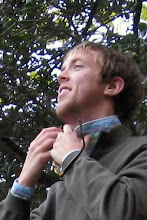This past weekend the MSID group took a 3-night trip to Toubacouta, a wetlands region about 7 hours to the south of Dakar due to poor road conditions, to study rural development issues.
We departed on Thursday, and after eating lunch at Professor Sene's house in Sokone, we arrived in the village of Toubacouta at about 5 in the afternoon. We, with a group of students from UCAD, toured around Toubacouta, seeing its beach, mosque and middle school before traveling to another village to "assist" with a Seereer wrestling match. During the match, Waly made me dance in front of about 200 locals!
Here is a photo of a wrestler that gives a sense of the mystical, spiritual, and ephemeral atmosphere of the match. It was truly indescribable.

Also, during the tour around Toubacouta, we came across the practice of a dance troupe, who we would see perform the following night during a dance showcase.

Friday morning we met with the public communications officer of a fishery in a village south of Toubacouta and with some public officials in Toubacouta. Here is a photo of a group of women who make a living drying fish and reselling it to sellers from markets in Dakar. It is one of the ways in which they can obtain and maintain financial security and independence.

After meeting with the regional administrator of Toubacouta, the group took a couple of pirogues to visit and study a marine nature reserve about 5km outside of the village. Here is a photo of Sonya, Josephine, and Margaretta with the driver of my pirogue.

After talking with the park ranger, we returned to Toubacouta to eat dinner and attend the aforementioned dance showcase.
The next day, we visited a woman's group in the very rural village of Keur Saloum Diané before visiting with nearly the whole population of another village called Keur Sevigne Korka. Both of the villages were lacking in infrastructure and human capital. The latter, however, had no school, no working-age males, and no medical staff. Josh, Kelsey, and I were invited into a room to see a mother with her newborn child. When we entered we found a premature baby and a dying woman with access to only traditional medicines. Additionally, one of the village elders stated that we were the only outsiders over a period of 105 years (including the government) to visit the village with the aim of finding out how its people live.
Here is a photo of our meeting with the woman's group in Keur Saloum Diané.

We left Keur Sevigne Korka to visit the daara in Sangako where I will be interning. I do not have any photos since my camera's batteries died; however, I can say that I am very excited for the internship and will apparently be learning some Arabic.
Sunday morning, we awoke to take part in a weekly ritual of Toubacouta, involving fire-based forest clearing, communal work, and a Chewbacca-looking overseer with a whip. After leaving the work area, we gave group presentations and left Toubacouta for less mosquito-infested lands!






















